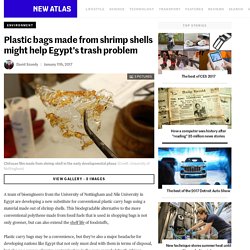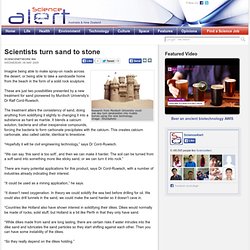

A graphene roll-out. MIT engineers have developed a continuous manufacturing process that produces long strips of high-quality graphene.

Sturdy Insulator Made of Wood. Sturdy Insulator Made of Wood COLLEGE PARK-- Engineers at the University of Maryland have created a new material that’s as insulating as Styrofoam, but stronger and much more environmentally friendly.

“This can insulate better than most other current thermal insulators, including Styrofoam. It is extremely promising to be used as energy efficient building materials,” said Tian Li, a postdoc student with Liangbing Hu’s group in the UMD department of materials science and engineering. She was named to Forbes Magazine’s “30 under 30” list of accomplished young adults in 2018. Wood “conducts” heat along the channels that were used when the tree was alive to shuttle water and nutrients from roots to leaves.
To test how much heat was insulated, they measured the temperature on one side of the nanowood, while on the other side of the wood, shining a light in one test and applying heat in another test. The secret to the nanowood is the removal of lignin, the part that makes it brown and rigid. Scientists have turned cooking oil into a material 200 times stronger than steel. Researchers have found a way to turn cheap, everyday cooking oil into the wonder material graphene - a technique that could greatly reduce the cost of making the much-touted nanomaterial.

Graphene is a single sheet of carbon atoms with incredible properties - it's 200 times stronger than steel, harder than diamond, and incredibly flexible. Under certain conditions, it can even be turned into a superconductor that carries electricity with zero resistance. That means the material has the potential to make better electronics, more effective solar cells, and could even be used in medicine. Last year, a study suggested that graphene could help mobile phone batteries last 25 percent longer, and the material has the potential to filter fuel out of thin air. But these applications have been limited by the fact that graphene usually has to be made in a vacuum at intense heat using purified ingredients, which makes it expensive to produce. Plastic bags made from shrimp shells might help Egypt's trash problem. A team of bioengineers from the University of Nottingham and Nile University in Egypt are developing a new substitute for conventional plastic carry bags using a material made out of shrimp shells.

Metal Foam Obliterates Bullets – and That’s Just the Beginning. Composite metal foams (CMFs) are tough enough to turn an armor-piercing bullet into dust on impact.

Given that these foams are also lighter than metal plating, the material has obvious implications for creating new types of body and vehicle armor – and that’s just the beginning of its potential uses. Afsaneh Rabiei, a professor of mechanical and aerospace engineering at NC State, has spent years developing CMFs and investigating their unusual properties. The video seen here shows a composite armor made out of her composite metal foams.
The bullet in the video is a 7.62 x 63 millimeter M2 armor piercing projectile, which was fired according to the standard testing procedures established by the National Institute of Justice (NIJ). And the results were dramatic. Hemp waste fibers form basis of supercapacitor more conductive than graphene. Comprised of a lone hexagonal honeycomb lattice layer of tightly packed carbon atoms, graphene is one of the strongest, lightest, and most conductive compounds ever discovered.

Bottom line, it’s an extraordinary composite. However, a scientist from New York’s Clarkson University says he’s found a way to manufacture hemp waste into a material “better than graphene.” Moreover, the scientist — known to his peers as Dr. David Mitlin — says creating this graphene-like hemp material costs but a minuscule fraction of what it takes to produce graphene. Presented at an American Chemical Society Meeting in San Francisco, Dr.
Wonder Material Mimics Desert Beetles and Cacti To Suck Water Out of Thin Air. Scientists grow high-quality graphene from tea tree extract. (Phys.org)—Graphene has been grown from materials as diverse as plastic, cockroaches, Girl Scout cookies, and dog feces, and can theoretically be grown from any carbon source.

However, scientists are still looking for a graphene precursor and growth method that is sustainable, scalable, and economically feasible, since these are all requirements for realizing widespread commercialization of graphene-based devices. In a new study, researchers have grown graphene from the tea tree plant Melaleuca alternifolia, the same plant used to make essential oils in traditional medicine. The researchers demonstrated that they could fabricate large-area, nearly defect-free graphene films from tea tree oil in as little as a few seconds to a few minutes, whereas current growth methods usually take several hours.
Unlike current methods, the new method also works at relatively low temperatures, does not require catalysts, and does not rely on methane or other nonrenewable, toxic, or explosive precursors. Scientists Invent a New, Lighter Steel That's as Strong as Titanium. From shipping containers to skyscrapers to turbines, good old steel is still the workhorse of our modern world.

Now, scientists are discovering new secrets to make the material better, lighter, and stronger. Today a team of material scientists at Pohang University of Science and Technology in South Korea announced what they're calling one of the biggest steel breakthroughs of the last few decades: an altogether new type of flexible, ultra-strong, lightweight steel. This new metal has a strength-to-weight ratio that matches even our best titanium alloys, but at one tenth the cost, and can be created on a small scale with machinery already used to make automotive-grade steel.
The study appears in Nature. "Because of its lightness, our steel may find many applications in automotive and aircraft manufacturing," says Hansoo Kim, the researcher that led the team. Bend, Don't Break Hansoo Kim B2 crystals (light gray) are dispersed in the aluminum-steel alloy (dark gray.) Scientists turn sand to stone. Research from Murdoch University could one day turn sandcastles into livable homes using the new technology.

Image: iStockphoto Imagine being able to make spray-on roads across the desert, or being able to take a sandcastle home from the beach in the form of a solid rock sculpture. These are just two possibilities presented by a new treatment for sand pioneered by Murdoch University’s Dr Ralf Cord-Ruwisch. The treatment alters the consistency of sand, doing anything from solidifying it slightly to changing it into a substance as hard as marble.
It blends a calcium solution, bacteria and other inexpensive compounds, forcing the bacteria to form carbonate precipitates with the calcium. “Hopefully it will be civil engineering technology,” says Dr Cord-Ruwisch. Microbial CaCO3 precipitation for the production of biocement. Whiffin, Victoria S. (2004) Microbial CaCO3 precipitation for the production of biocement. PhD thesis, Murdoch University. The hydrolysis of urea by the widely distributed enzyme urease is special in that it is one of the few biologically occurring reactions that can generate carbonate ions without an associated production of protons. When this hydrolysis occurs in a calcium-rich environment, calcite (calcium carbonate) precipitates from solution forming a solid-crystalline material.
The binding strength of the precipitated crystals is highly dependent on the rate of carbonate formation and under suitable conditions it is possible to control the reaction to generate hard binding calcite cement (or Biocement). The objective of this thesis was to develop an industrially suitable cost-effective microbial process for the production of urease active cells and investigate the potential for urease active cells to act as a catalyst for the production of Biocement. From sandcastles to solid rock.
Research from Murdoch University could one day turn sandcastles into livable homes / Image: Istockphoto These are just two possibilities presented by a new treatment for sand pioneered by Murdoch University’s Dr Ralf Cord-Ruwisch.

The treatment alters the consistency of sand, doing anything from solidifying it slightly to changing it into a substance as hard as marble. It blends a calcium solution, bacteria and other inexpensive compounds, forcing the bacteria to form carbonate precipitates with the calcium. This creates calcium carbonate, also called calcite, identical to limestone. “Hopefully it will be civil engineering technology,” says Dr Cord-Ruwisch.
“We can say ‘this sand is too soft’, and then we can make it harder.